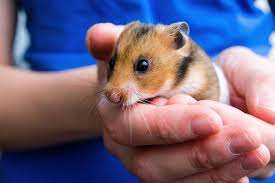 There are about 20 different breeds of hamster but not all of them are suitable to be household pets. The most common is the Syrian Hamster (also known as the golden or standard hamster) and Dwarf hamsters (which are also popular and are much smaller in stature) e.g. Russian, Chinese and Roborovski.
There are about 20 different breeds of hamster but not all of them are suitable to be household pets. The most common is the Syrian Hamster (also known as the golden or standard hamster) and Dwarf hamsters (which are also popular and are much smaller in stature) e.g. Russian, Chinese and Roborovski.
Housing
- Hamsters need exercise and so require as big a cage as possible.
- A hamster cage must have a place for your pet to rest, hide, play, exercise and feed.
- Keep the cage indoors, out of direct sunlight and draughts.
Bedding
- A good, absorbent floor covering inside the cage is essential. PAWS recommends Carefresh or Back 2 Nature as these are highly absorbent and good at reducing odour.
- Use soft paper and woolly bedding for nesting material.
- Clean the cage out completely every week
- Do not place hay or straw in a hamster’s cage – these tough strands can hurt hamster’s cheek pouches.
- Never use shredded newspapers or magazines as bedding for your hamster as the ink used in the printing process is toxic.
Feeding
- At PAWS we recommend Amos Hamster Mix, which is available from the shop.
- Supplement a hamster’s diet with occasional, small amounts of fruit and vegetables. Too much of this can give your pet an upset stomach.
- Remove uneaten food from the cage.
- Provide clean, fresh drinking water daily from a gravity-fed bottle.
Handling
- Using your hands, gently scoop your hamster from its cage.
- Hamsters are nocturnal and you should never wake them up. It makes them very grumpy!
- Never wake your hamster by picking it up as this will frighten it and may cause it to bite.
Syrian Hamsters
The Syrian hamster is the most common of the hamsters. There are more than 40 different colour types of the Syrian hamster. Some of the colours are golden, cream, cinnamon, sable, yellow, yellow black, black, gray, white, honey, and blond. They also come in different coat types which can range from long hair to short hair, and satin and rex coated. They have different patterns which include banded, dominant spot, tortoiseshell, and calico.
Did you Know
- Can grow to be about 6-7 inches and have a short tail.
- They have hairless feet with 4 toes on their front feet and 5 toes on their back feet.
- They have expandable cheek pouches and will live for 2-3 years.
- They are friendly, but are solitary creatures and cannot live with another hamster.
Dwarf Hamsters
There are three types of dwarf hamster; Chinese, Russian and Roborovski. These hamsters are different to the Syrian hamster in that they are omnivores and, as such, need a different type of food. You will also need to provide a cage with smaller bars to prevent escape, and you must never feed these hamsters with fruit as they are intolerant to sugar. Visit us at the shop for more information about how to care for this type of hamster. They can live with other Dwarf Hamsters unlike Syrian Hamsters.
Did you Know
The Dwarf Campbell’s Russian hamster is from central Asia.
- Can grow to be about 4 inches in length and have furry feet
- They have a plump rounded body.
- Either short haired or satin coated with patterns (inc. mottled and platinum)
- Hair colours range from golden, beige, black, lilac, blue, opal, dove, champagne, and albino.
- less tolerant of handling and may nip.
- can breed with the Dwarf Winter White Russian hamster.
The Dwarf Winter White Russian Hamster is from Siberia.
- Can grow to be between 3-4 inches in length and also have furry feet.
- Have expandable cheek pouches and a bullet shaped body.
- Can turn white in the winter due to lack of sunlight.
- less tolerant of handling, but are less likely to nip than the Dwarf Campbell’s Russian hamster.
The Chinese hamster is from China
- 4 inches long with a noticeable tail.
- They have a dark brown back and an off white belly.
- They are very timid, but rarely nip.
The Robrovski hamster comes from Mongolia and China.
- They are the smallest hamster at only 2 inches in length.
- They are a sandy gold with a white belly and have distinctive white eyebrow markings.
- There are many different species of hamsters, but only a few can be kept as pets but there is still a wide variety to choose from.
Dwarf hamsters aren’t as ready to be handled as Syrian hamsters, but will still make a great pet.

